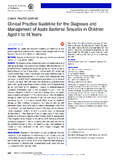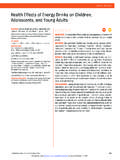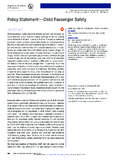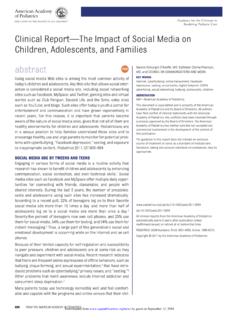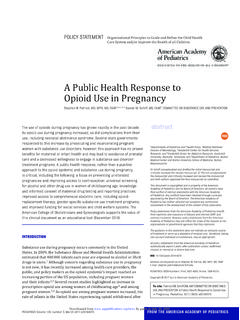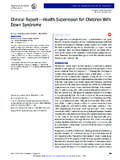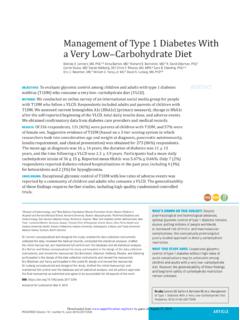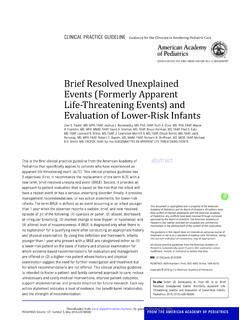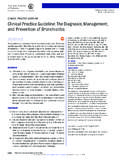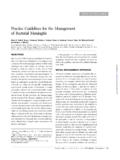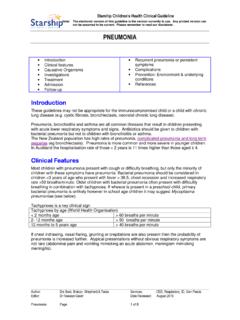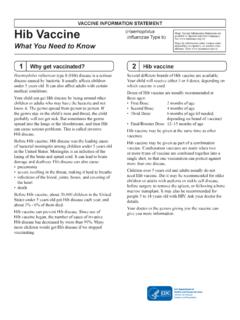Transcription of Organizational Principles to Guide and Define the …
1 Clinical Practice Guideline Febrile Seizures:Guideline for the Neurodiagnostic Evaluation of theChild With a Simple Febrile SeizureabstractOBJECTIVE:To formulate evidence-based recommendations for healthcare professionals about the diagnosis and evaluation of a simplefebrile seizure in infants and young children 6 through 60 months ofage and to revise the practice guideline published by the AmericanAcademy of Pediatrics (AAP) in :This review included search and analysis of the medicalliterature published since the last version of the guideline. Physicianswith expertise and experience in the fields of neurology and epilepsy,pediatrics, epidemiology, and research methodologies constituted asubcommittee of the AAP Steering Committee on Quality Improvementand Management.
2 The steering committee and other groups within theAAP and organizations outside the AAP reviewed the guideline. Thesubcommittee member who reviewed the literature for the 1996 AAPpractice guidelines searched for articles published since the lastguideline through 2009, supplemented by articles submitted by othercommittee members. Results from the literature search were providedto the subcommittee members for review. Interventions of direct inter-est included lumbar puncture, electroencephalography, blood studies,and neuroimaging. Multiple issues were raised and discussed itera-tively until consensus was reached about recommendations. Thestrength of evidence supporting each recommendation and thestrength of the recommendation were assessed by the committeemember most experienced in informatics and epidemiology andgraded according to AAP :Clinicians evaluating infants or young children after asimple febrile seizure should direct their attention toward identifyingthe cause of the child s fever.
3 Meningitis should be considered in thedifferential diagnosis for any febrile child, and lumbar puncture shouldbe performed if there are clinical signs or symptoms of concern. Forany infant between 6 and 12 months of age who presents with a seizureand fever, a lumbar puncture is an option when the child is considereddeficient inHaemophilus influenzaetype b (Hib) orStreptococcuspneumoniaeimmunizations (ie, has not received scheduled immuniza-tions as recommended), or when immunization status cannot be de-termined, because of an increased risk of bacterial meningitis. A lum-bar puncture is an option for children who are pretreated withantibiotics. In general, a simple febrile seizure does not usually requirefurther evaluation, specifically electroencephalography, blood studies,or ;127:389 394 SUBCOMMITTEE ON FEBRILE SEIZURESKEY WORD seizureABBREVIATIONSAAP American Academy of PediatricsHib Haemophilus influenzaetype bEEG electroencephalogramCT computed tomographyThe recommendations in this report do not indicate an exclusivecourse of treatment or serve as a standard of medical , taking into account individual circumstances, may document is copyrighted and is property of the AmericanAcademy of Pediatrics and its Board of Directors.
4 All authorshave filed conflict of interest statements with the AmericanAcademy of Pediatrics. Any conflicts have been resolved througha process approved by the Board of Directors. The AmericanAcademy of Pediatrics has neither solicited nor accepted anycommercial involvement in the development of the content ofthis clinical practice guidelines from the American Academy ofPediatrics automatically expire 5 years after publication unlessreaffirmed, revised, or retired at or before that (ISSN Numbers: Print, 0031-4005; Online, 1098-4275).Copyright 2011 by the American Academy of PediatricsFROM THE AMERICAN ACADEMY OF PEDIATRICSO rganizational Principles to Guide and Define the ChildHealth Care System and/or Improve the Health of all ChildrenPEDIATRICS Volume 127, Number 2, February 2011389 by guest on January 4, from DEFINITION OF THE PROBLEMThis practice guideline provides recom-mendations for the neurodiagnosticevaluation of neurologically healthy in-fants and children 6 through 60 monthsof age who have had a simple febrile sei-zure and present for evaluation within 12hours of the event.
5 It replaces the 1996practice practiceguideline is not intended for patientswho have had complex febrile seizures(prolonged, focal, and/or recurrent),and it does not pertain to children withprevious neurologic insults, known cen-tral nervous system abnormalities, orhistory of afebrile AUDIENCE AND PRACTICESETTINGThis practice guideline is intended foruse by pediatricians, family physicians,child neurologists, neurologists, emer-gency physicians, nurse practitioners,and other health care providers whoevaluate children for febrile febrile seizure is a seizure accompa-nied by fever (temperature F or38 C2by any method), without centralnervous system infection, that occurs ininfants and children 6 through 60months of age. Febrile seizures occur in2% to 5% of all children and, as such,make up the most common convulsiveevent in children younger than 60months.
6 In 1976, Nelson and Ellenberg,3using data from the National Collabora-tive Perinatal Project, further defined fe-brile seizures as being either simple orcomplex. Simple febrile seizures weredefined as primary generalized seizuresthat lasted for less than 15 minutes anddid not recur within 24 hours. Complexfebrile seizures were defined as focal,prolonged ( 15 minutes), and/or recur-rent within 24 hours. Children who hadsimple febrile seizures had no evidenceof increased mortality, hemiplegia, ormental retardation. During follow-upevaluation, the risk of epilepsy after asimple febrile seizure was shown to beonly slightly higher than that of the gen-eral population, whereas the chief riskassociated with simple febrile seizureswas recurrence in one-third of the chil-dren.
7 The authors concluded that simplefebrile seizures are benign events withexcellent prognoses, a conclusion reaf-firmed in the 1980 consensus statementfrom the National Institutes of ,4 The expected outcomes of this practiceguideline include the following:1. Optimize clinician understanding ofthe scientific basis for the neurodi-agnostic evaluation of children withsimple febrile Aid the clinician in decision-makingby using a structured Optimize evaluation of the child whohas had a simple febrile seizure bydetecting underlying diseases, min-imizing morbidity, and reassuringanxious parents and Reduce the costs of physician andemergency department visits, hospi-talizations, and unnecessary Educate the clinician to understandthat a simple febrile seizure usuallydoes not require further evaluation,specifically electroencephalography,blood studies, or update the clinical practice guidelineon the neurodiagnostic evaluation ofchildren with simple febrile seizures.
8 1the American Academy of Pediatrics(AAP) reconvened the Subcommittee onFebrile Seizures. The committee waschaired by a child neurologist and con-sisted of a neuroepidemiologist, 3 addi-tional child neurologists, and a practic-ing pediatrician. All panel membersreviewed and signed the AAP voluntarydisclosure and conflict-of-interest conflicts were reported. Participationin the guideline process was voluntaryand not paid. The guideline was reviewedby members of the AAP Steering Commit-tee on Quality Improvement and Manage-ment; members of the AAP Section on Ad-ministration and Practice Management,Section on Developmental and Behav-ioral Pediatrics, Section on Epidemiol-ogy, Section on Infectious Diseases, Sec-tion on Neurology, Section on NeurologicSurgery, Section on Pediatric EmergencyMedicine, Committee on Pediatric Emer-gency Medicine, Committee on Practiceand Ambulatory Medicine, Committee onChild Health Financing, Committee on In-fectious Diseases, Committee on MedicalLiability and Risk Management, Councilon Children With Disabilities, and Councilon Community Pediatrics.
9 And membersof outside organizations including theChild Neurology Society, the AmericanAcademy of Neurology, the American Col-lege of Emergency Physicians, and mem-bers of the Pediatric Committee of theEmergency Nurses comprehensive review of the evidence-based literature published from 1996 toFebruary 2009 was conducted to dis-cover articles that addressed the diag-nosis and evaluation of children withsimple febrile seizures. Preference wasgiven to population-based studies, butgiven the scarcity of such studies, datafrom hospital-based studies, groups ofyoung children with febrile illness, andcomparable groups were were made on the basis of asystematic grading of the quality ofevi-dence and strength of the original practice parameter,1203medical journal articles were reviewedand abstracted.
10 An additional 372 arti-cles were reviewed and abstracted forthis update. Emphasis was placed on ar-ticles that differentiated simple febrileseizures from other types of seizures. Ta-bles were constructed from the 70 arti-cles that best fit these evidence-based approach to Guide -line development requires that the evi-dence in support of a recommendationbe identified, appraised, and summa-rized and that an explicit link between390 FROM THE AMERICAN ACADEMY OF PEDIATRICS by guest on January 4, from evidence and recommendations be de-fined. Evidence-based recommendationsreflect the quality of evidence and thebalance of benefit and harm that is antic-ipated when the recommendation is fol-lowed. The AAP policy statement Classi-fying Recommendations for ClinicalPractice Guidelines 5was followed indesignating levels of recommendations(see Fig 1).
